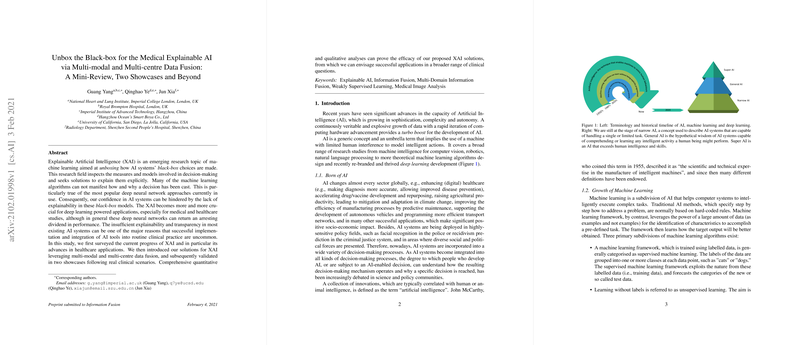Unbox the Black-box for Medical Explainable AI via Multi-modal and Multi-centre Data Fusion
The paper "Unbox the Black-box for the Medical Explainable AI via Multi-modal and Multi-centre Data Fusion" discusses the growing relevance and the development of Explainable AI (XAI) in medical applications. The scope of the research is focused on providing interpretability to deep learning models, particularly in medical image analysis, by leveraging multi-modal and multi-centre data fusion strategies. The research highlights two practical applications in medical imaging: classification of COVID-19 infections using CT data and segmentation of brain ventricles with MRI data.
Overview of Explainable AI
The paper begins by contextualizing the importance of XAI within AI's broader domain, especially as AI systems permeate decision-making in sensitive fields like healthcare. The lack of transparency in deep learning models, characterized as 'black-box,' limits their integration into clinical practice. The paper points out the necessity of trustable AI systems, which necessitate validity, privacy, responsibility, and crucially, explainability. By providing insights into decision-making processes, XAI can promote trust and facilitate the adoption of AI technologies in clinical settings.
Theoretical and Practical Implications
In an overview of existing XAI methods, the paper categorizes techniques into intrinsic and post-hoc approaches, which can be model-specific or model-agnostic. It emphasizes that a single method cannot universally address all interpretability needs and a combination of strategies is often required. By deploying XAI methods such as attention mechanisms, CAM, LIME, and SHAP, the paper aims to achieve both local and global interpretability in the developed models.
Showcase Applications
The research underlines its findings with two showcases:
- COVID-19 Classification: The first application involves the classification of CT images for identifying COVID-19 infected individuals. The proposed model integrates a slice integration module with a noisy correction module to deal with multi-centre data variability and noise in image annotations. The model achieves higher accuracy and AUC than state-of-the-art models, demonstrating its competency in operationalizing COVID-19 diagnostics.
- Brain Ventricle Segmentation: The second application applies to segment brain ventricles from MRI images, specifically in patients with hydrocephalus. The proposed method overcomes challenges associated with varying slice thickness by using multimodal training with labeled and unlabeled data. The segmentation model shows superior performance over existing methods and provides post-hoc interpretability via PCA analysis and latent space exploration.
Implications and Future Directions
The paper elucidates several theoretical implications for AI development in healthcare. By fostering accurate interpretability, the research encourages developing algorithmic solutions that not only predict outcomes but also rationalize their decision pathways. Practically, the insights drawn from this paper could help design better AI tools across various medical fields, ultimately leading to broader acceptance and deployment of AI in healthcare.
The future of XAI in healthcare seems promising, especially with potential developments in seamless multimodal data integration and federated learning for enhanced model generalization. Continued improvements in XAI could address existing ethical and legislative concerns, thereby paving the way for safer, more trustable AI interventions in clinical practice.
In conclusion, the proposed methodologies present a step forward in making AI systems transparent and interpretable, thus enhancing their applicability in healthcare. This research contributes significantly to the ongoing pursuit of reliable, transparent AI systems, which hold the promise of better integration into sensitive fields like healthcare, where understanding and trust in decision-making processes are paramount.
